Black-on-black San Ildefonso Small Storage Jar by Rosalie Aguilar - C3623D
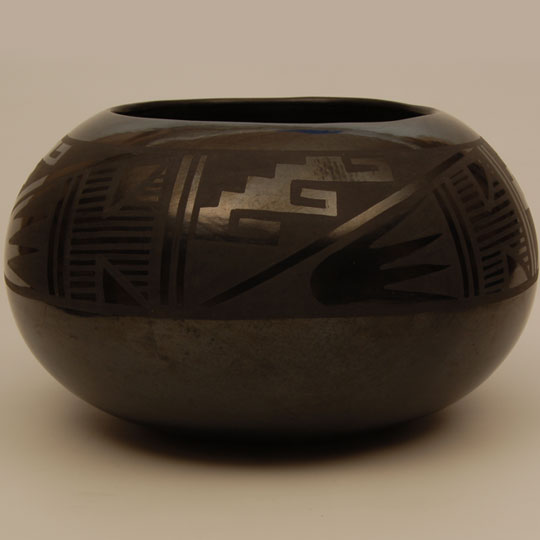 Rosalie Simbola Aguilar (1898-1947) was originally from Picuris Pueblo. In 1922, at the age of 24, she married Joe Aguilar (1898-1965) of San Ildefonso Pueblo and they settled there. The couple had eleven children over a period of twenty-four years, yet, Rosalie and Joe found time to produce beautiful pottery in the San Ildefonso style. Rosalie, in addition to producing black-on-black pottery also made carved designs. She and Rose Gonzales were the only two potters at the pueblo to do carved wares and both were imports from other pueblos.
Rosalie Simbola Aguilar (1898-1947) was originally from Picuris Pueblo. In 1922, at the age of 24, she married Joe Aguilar (1898-1965) of San Ildefonso Pueblo and they settled there. The couple had eleven children over a period of twenty-four years, yet, Rosalie and Joe found time to produce beautiful pottery in the San Ildefonso style. Rosalie, in addition to producing black-on-black pottery also made carved designs. She and Rose Gonzales were the only two potters at the pueblo to do carved wares and both were imports from other pueblos.
Polacca-Style Hopi Polychrome Bowl by Nampeyo of Hano - C3304
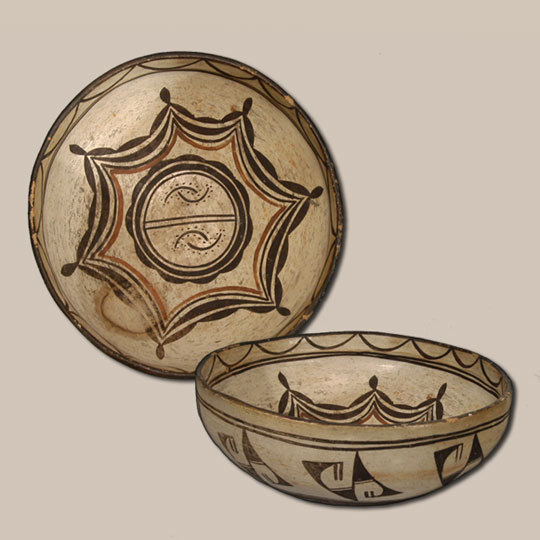 I am confident Nampeyo of Hano made this bowl. I believe she made it between 1890 and 1895. The reasoning for this attribution to Nampeyo is based on a number of clues.
I am confident Nampeyo of Hano made this bowl. I believe she made it between 1890 and 1895. The reasoning for this attribution to Nampeyo is based on a number of clues.
The shape and construction of the bowl, along with the design elements and artistic execution, all point to her hand. The Polacca Style C designs she used on this bowl appear to be adapted from popular 1860 to 1890 Polacca wares. Who else was using these early designs but Nampeyo?
In the 1900 federal census, only Nampeyo and one other woman called themselves "potters." (Kramer, p.34). We know, according to Fewkes, that Nampeyo began to "cleverly imitate" Sikyatki ware as early as 1895. Based on this, I believe some of the pieces she made from Polacca wares predated those made from Sikyatki wares and were as early as 1890.
Hopi Polychrome Seed Jar with Avian Designs by Lena Chio Charlie - C3623C
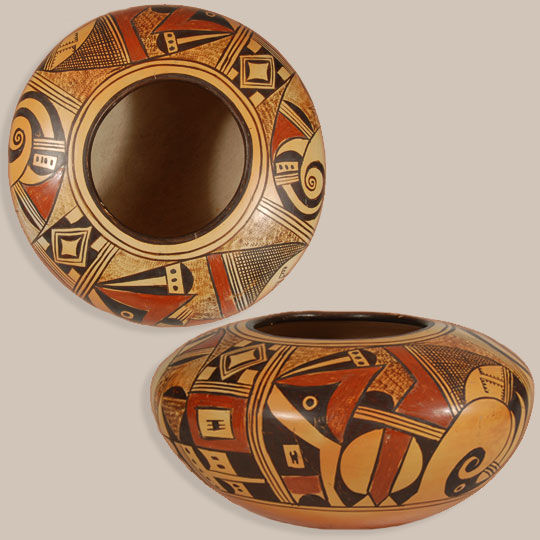 Lena Chio Charlie (ca.1908-ca.1960s) Corn Woman was a member of the Corn Clan, as was Nampeyo of Hano. She was a sister of Irene Shupla and cousins of Sadie Adams, Patty Maho, Ruth Paymella and grandmother to famed Hopi-Tewa artist Neil David, Sr.
Lena Chio Charlie (ca.1908-ca.1960s) Corn Woman was a member of the Corn Clan, as was Nampeyo of Hano. She was a sister of Irene Shupla and cousins of Sadie Adams, Patty Maho, Ruth Paymella and grandmother to famed Hopi-Tewa artist Neil David, Sr.
Her pottery is desirable by collectors for its very high quality and warm orange glow. Her designs are beautifully conceived and executed. She often used stippling, in the style of Nampeyo of Hano, as seen on this jar.
Acoma Pueblo Polychrome Pottery Jar by Mary Histia - C3623B
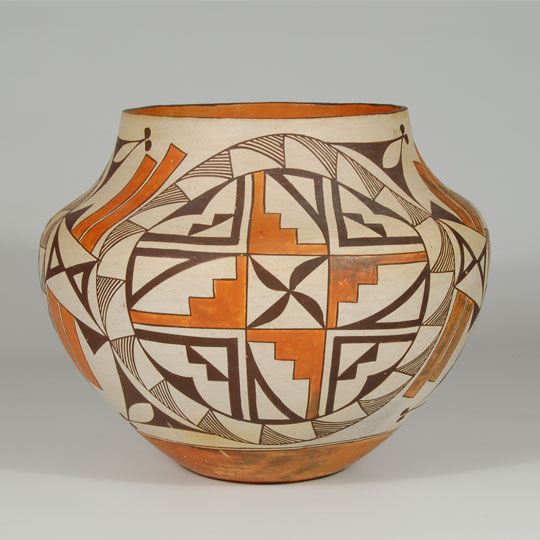 The jar is certainly of the quality of those by Mary Histia. It sits straight, is thin-walled and was decorated with precision. Designs within medallions are documented to Mary Histia. There is a Mary Histia jar documented in Dillingham that features the same stepped elements as shown in orange in this jar. In the Dillingham illustration, the four stepped elements are centered with a flower and in this jar they are centered with a propeller-like element.
The jar is certainly of the quality of those by Mary Histia. It sits straight, is thin-walled and was decorated with precision. Designs within medallions are documented to Mary Histia. There is a Mary Histia jar documented in Dillingham that features the same stepped elements as shown in orange in this jar. In the Dillingham illustration, the four stepped elements are centered with a flower and in this jar they are centered with a propeller-like element.
Historic Acoma Pueblo Tall-neck Polychrome Jar - C3623A
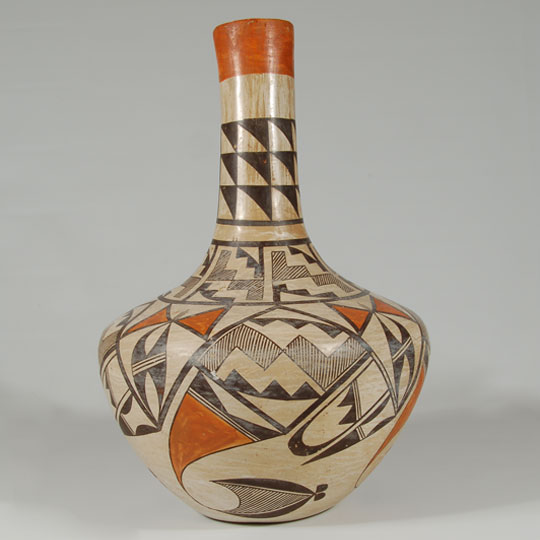 Changes in traditional Acoma pottery occurred as early as 1880 with the arrival of the railroad in New Mexico, and continued in the 1930s when Route 66 was built along the path of the old AT&SF (Atchison, Topeka and Santa Fe) Railway line. These events provided Acoma and Laguna potters with a steady source of tourists as buyers for their wares.
Changes in traditional Acoma pottery occurred as early as 1880 with the arrival of the railroad in New Mexico, and continued in the 1930s when Route 66 was built along the path of the old AT&SF (Atchison, Topeka and Santa Fe) Railway line. These events provided Acoma and Laguna potters with a steady source of tourists as buyers for their wares.
Each historic Pueblo pottery vessel should be seen as a national treasure
Christies Auction in New York recently sold a Chinese bowl for $11.7 Million U. S. dollars. The buyer was a man from China. It is refreshing to see that he is interested enough in his country's art to spend serious money to purchase it and have it return to his nation.
If only we could foster that interest in the United States for our countrymen to more seriously want to collect rare, early Pueblo pottery. There is probably not a Pueblo pot on the market priced at over $250,000, and most are not priced over $25,000, yet, there is no national urge to purchase them by some collectors and museums.
We do appreciate those clients who value historic pottery as we value it and we praise their efforts to collect and protect it for future generations. Each historic Pueblo pottery vessel should be seen as a national treasure. Their preservation should be a national priority for museums and individual collectors.
Thank you,-Al
l
Original Painting of a Navajo Female Dancer by Andrew Van Tsihnahjinnie - C3619D
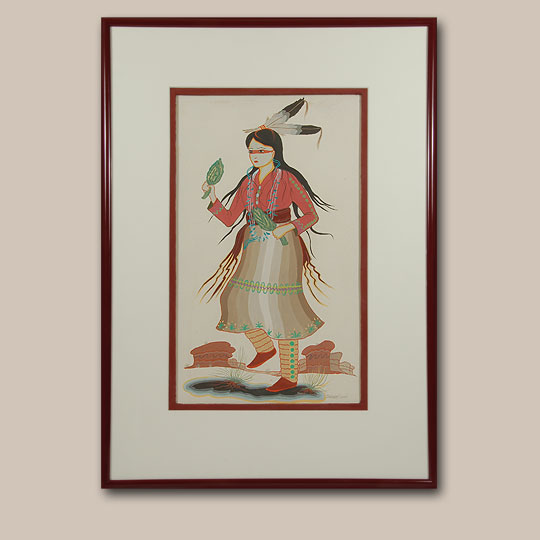 "Andrew Tsihnahjinnie, in many respects-incisive interpretation, spontaneity of brushwork, originality of color, vigor of draftsmanship and vitality of action-had no equals among the artists of the studio and perhaps few superiors among modern painters. If equanimity and self-confidence were to rule his artistic abilities, Tsihnahjinnie might well be one of America's top-ranking painters. In the brief seasons when he felt freed to paint the things he knew so deeply, without troubled concern for doing otherwise, his work attained a trenchant beauty, unique in modern art. Dorothy Dunn, 1963
"Andrew Tsihnahjinnie, in many respects-incisive interpretation, spontaneity of brushwork, originality of color, vigor of draftsmanship and vitality of action-had no equals among the artists of the studio and perhaps few superiors among modern painters. If equanimity and self-confidence were to rule his artistic abilities, Tsihnahjinnie might well be one of America's top-ranking painters. In the brief seasons when he felt freed to paint the things he knew so deeply, without troubled concern for doing otherwise, his work attained a trenchant beauty, unique in modern art. Dorothy Dunn, 1963
Historic Tesuque Pueblo 19th-century Rain God Figurine - 25623
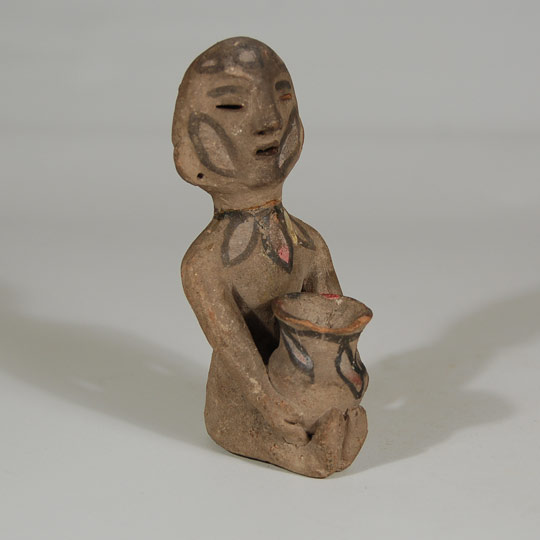 This Tesuque Pueblo figurine is typical of the style made at the turn of the 20th century. The figurine was covered in cream slip over which the design was painted in yellow and pink within black outlined elements. The figurine has painted designs on his head, cheeks, neck and on the jar on his lap. The painted designs are typical of the early 1900s figurines. This is one of the more elaborately painted rain gods which makes one suspect it is one of the earlier ones before demand increased so significantly that potters began producing faster and decorating less.
This Tesuque Pueblo figurine is typical of the style made at the turn of the 20th century. The figurine was covered in cream slip over which the design was painted in yellow and pink within black outlined elements. The figurine has painted designs on his head, cheeks, neck and on the jar on his lap. The painted designs are typical of the early 1900s figurines. This is one of the more elaborately painted rain gods which makes one suspect it is one of the earlier ones before demand increased so significantly that potters began producing faster and decorating less.
Acoma Pueblo Candlestick and Ash Tray Combination - 25585
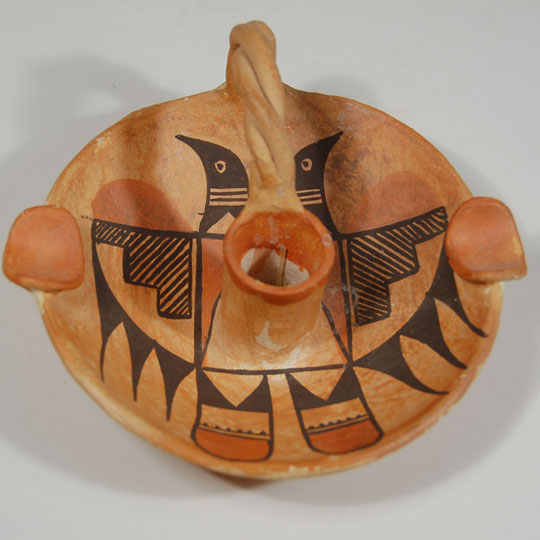 This Acoma Pueblo candleholder is combined with an ashtray to achieve dual use, an idea which must have appealed to tourists who collected either item. The base clay has been slipped in orange and painted in polychrome colors that feature the traditional Acoma dual bird design. On the underside is painted Acoma N.M. but no name of a potter. It was typical in the mid-20th century to only identify the pueblo and not the potter.
This Acoma Pueblo candleholder is combined with an ashtray to achieve dual use, an idea which must have appealed to tourists who collected either item. The base clay has been slipped in orange and painted in polychrome colors that feature the traditional Acoma dual bird design. On the underside is painted Acoma N.M. but no name of a potter. It was typical in the mid-20th century to only identify the pueblo and not the potter.
“A Shady Nook—Late Afternoon” Painting by Joseph R. Willis - C3824A
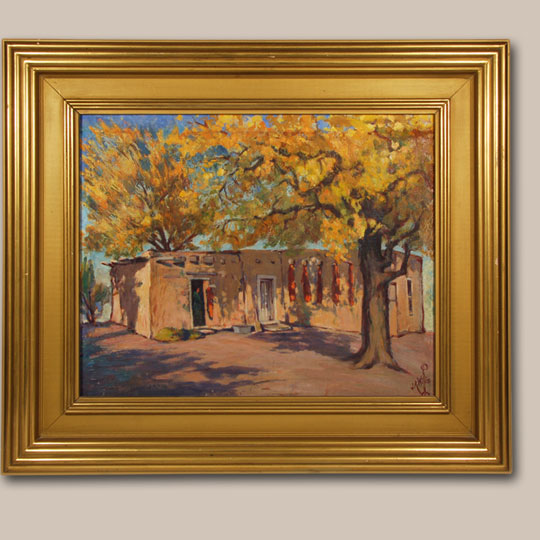 Joseph Roy (J. R.) Willis (1876-1960) was a legend in Albuquerque. He was a slim gent with a small mustache. He wore capes. He twirled canes. He smoked Pall Mall cigarettes in an ivory holder. He loved, more than anything, to discuss his paintings. Albuquerque old-timers, who were fascinated by his foppish bearing, remember him. He had flair, a flakiness that today would be considered weird. J. R. Willis was just different. He was an artist. He came from the Southeast to chronicle the Great Southwest. Willis learned art on slates. He made fashion drawings for the Atlanta Constitution. He painted backdrops for Universal Studios in Hollywood. In 1917, Willis left for New York to discuss cartoon syndication. He stopped in Arizona to sketch Hopis. He decided to stay in the Great Southwest. He moved to Gallup, New Mexico, and set himself up as a photographer, and toured the reservations to photograph Navajos, Hopis, Zunis, Lagunas and Acomas. He would then use the photos as sources for his paintings.
Joseph Roy (J. R.) Willis (1876-1960) was a legend in Albuquerque. He was a slim gent with a small mustache. He wore capes. He twirled canes. He smoked Pall Mall cigarettes in an ivory holder. He loved, more than anything, to discuss his paintings. Albuquerque old-timers, who were fascinated by his foppish bearing, remember him. He had flair, a flakiness that today would be considered weird. J. R. Willis was just different. He was an artist. He came from the Southeast to chronicle the Great Southwest. Willis learned art on slates. He made fashion drawings for the Atlanta Constitution. He painted backdrops for Universal Studios in Hollywood. In 1917, Willis left for New York to discuss cartoon syndication. He stopped in Arizona to sketch Hopis. He decided to stay in the Great Southwest. He moved to Gallup, New Mexico, and set himself up as a photographer, and toured the reservations to photograph Navajos, Hopis, Zunis, Lagunas and Acomas. He would then use the photos as sources for his paintings.
Original Watercolor entitled “Sunlight over Adobes” by Tom Perkinson - C3322
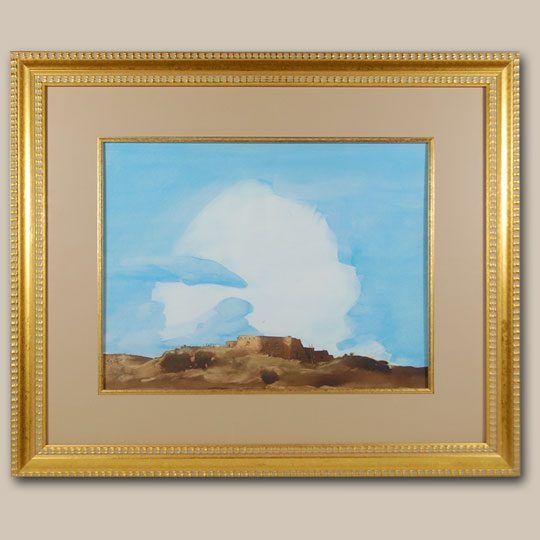 Tom Perkinson is one of the young artists who came to New Mexico and fell in love with what he saw and has now lived here for 45 years. He moved to New Mexico to pursue his Master's Degree in Fine Arts at the University of New Mexico, and, while doing so, painted the landscape, which started his fascination with southwestern imagery. He found that the drama of light and shadow, and the mystery that characterizes the geography of New Mexico, held great appeal to him. He recognized that he had found an infinite source of inspiration in the panorama of the southwest landscape. His paintings reflect his skill and mastery of this challenging medium, watercolor. Those of us who are not artists owe a great debt to those who are preserving the beauty of New Mexico for us and for the future as it is surely to change over time.
Tom Perkinson is one of the young artists who came to New Mexico and fell in love with what he saw and has now lived here for 45 years. He moved to New Mexico to pursue his Master's Degree in Fine Arts at the University of New Mexico, and, while doing so, painted the landscape, which started his fascination with southwestern imagery. He found that the drama of light and shadow, and the mystery that characterizes the geography of New Mexico, held great appeal to him. He recognized that he had found an infinite source of inspiration in the panorama of the southwest landscape. His paintings reflect his skill and mastery of this challenging medium, watercolor. Those of us who are not artists owe a great debt to those who are preserving the beauty of New Mexico for us and for the future as it is surely to change over time.
Miniature Papago Basket Tray of Grass and Devil’s Claw Fibers - C3353.02
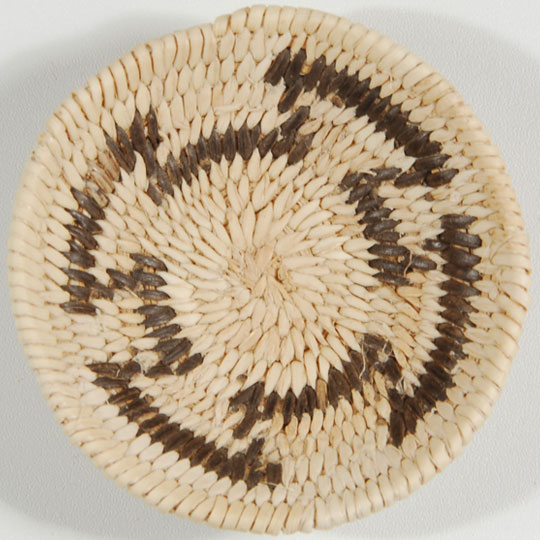 The Tohono O'odham (formerly Papago) and Akimel O'odham (formerly Pima)are kin groups who weave baskets in much the same style. It is sometimes difficult to determine from which tribe a basket originated. There are very few women from either tribe who weave baskets in the old style. In the mid-20th century, basket makers began making miniature baskets to fill the need of collectors. Such small baskets had no function for the Natives.
The Tohono O'odham (formerly Papago) and Akimel O'odham (formerly Pima)are kin groups who weave baskets in much the same style. It is sometimes difficult to determine from which tribe a basket originated. There are very few women from either tribe who weave baskets in the old style. In the mid-20th century, basket makers began making miniature baskets to fill the need of collectors. Such small baskets had no function for the Natives.
Historic Kewa - Santo Domingo Pueblo Deep Serving Bowl - C3825
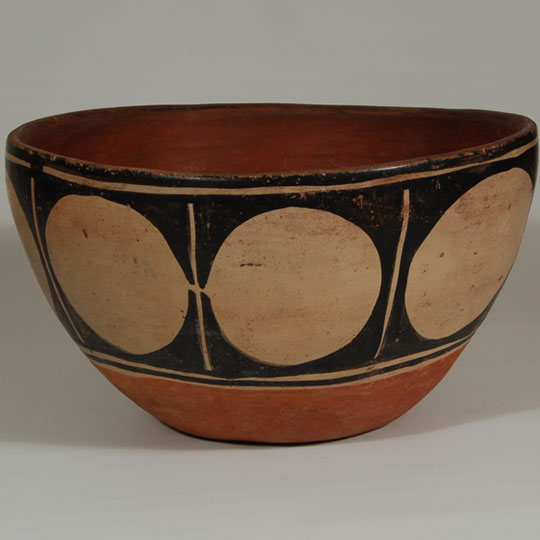 Pueblos are associated with certain pottery designs that become somewhat a hallmark of their pottery. San Ildefonso is associated with eagle feather and Avanyu designs, Santa Clara has become associated with the impressed bear paw, Acoma Pueblo is tied to its fine line work and Zuni Pueblo is associated with the heart line deer.
Pueblos are associated with certain pottery designs that become somewhat a hallmark of their pottery. San Ildefonso is associated with eagle feather and Avanyu designs, Santa Clara has become associated with the impressed bear paw, Acoma Pueblo is tied to its fine line work and Zuni Pueblo is associated with the heart line deer.
The most prominent designs associated with Santo Domingo Pueblo are black triangles that form a star pattern and the cream ovals outlined in black squares. This deep bowl has the large cream ovals or circles outlined in black that are so tied to its name. Each potter may treat the pattern slightly different, but overall, it comes out appearing the same.
Hopi Painting entitled “Dream of Bighorn People” by Dawakema - C3821A
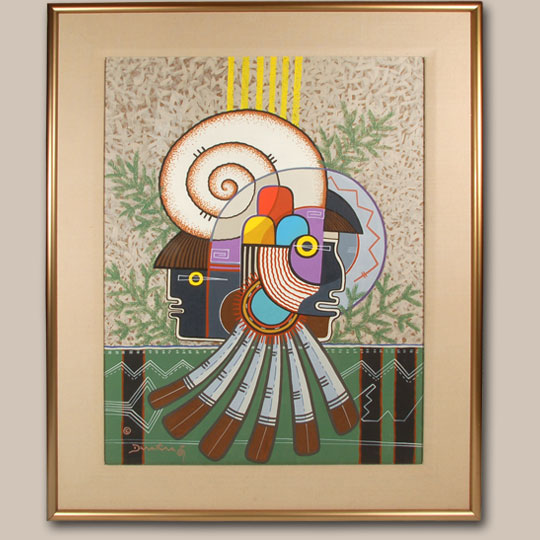 Milland Lomakema was a member of the Artist Hopid, a group organized in 1973 by Hopi artists Michael Kabotie, Terrance Talaswaima, and Neil David, Sr. The objectives of the group were to use Hopi art to instill pride and identity, to educate the world to the aesthetic and cultural values of the Hopi, to develop new ideas in Hopi art, to control the aesthetic for Hopi art, and to document Hopi history through the visual arts.
Milland Lomakema was a member of the Artist Hopid, a group organized in 1973 by Hopi artists Michael Kabotie, Terrance Talaswaima, and Neil David, Sr. The objectives of the group were to use Hopi art to instill pride and identity, to educate the world to the aesthetic and cultural values of the Hopi, to develop new ideas in Hopi art, to control the aesthetic for Hopi art, and to document Hopi history through the visual arts.
Historic Acoma Pueblo Polychrome Jar with Rainbow Band - C3466E
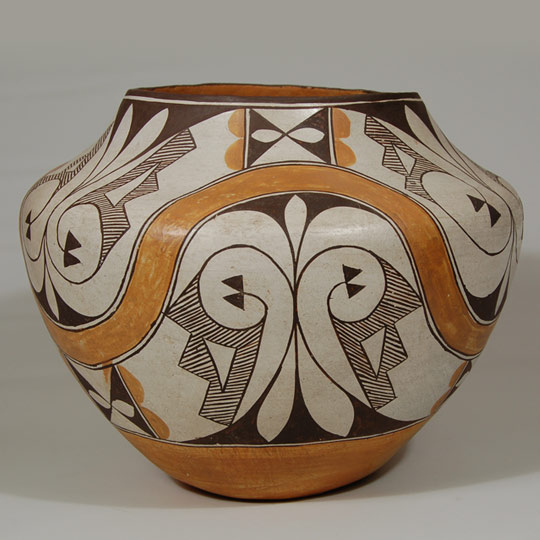 Various dates have been established for the end of the historic period of pottery production. Some collectors have stated that 1880s was the end period, others have stated the 1920s, but noted authority Jonathan Batkin selected 1940 and it is this last date that we have chosen to use. There are logical reasons for all the dates, but selecting one is an arbitrary choice that really has no effect on the quality or desirability of pottery. A pottery vessel is no better or worse by attaching a date of manufacture to it.
Various dates have been established for the end of the historic period of pottery production. Some collectors have stated that 1880s was the end period, others have stated the 1920s, but noted authority Jonathan Batkin selected 1940 and it is this last date that we have chosen to use. There are logical reasons for all the dates, but selecting one is an arbitrary choice that really has no effect on the quality or desirability of pottery. A pottery vessel is no better or worse by attaching a date of manufacture to it.
This Acoma jar is probably closer to circa 1940 than to any other period. The traditional elements of Acoma Polychrome are present for a vessel of that time period. The orange-buff underbody, rag-wiped white slip, orange neck interior, and black rim top, as well as the high shoulder, short neck, absence of flexure at the transition from under- to mid-body and the absence of a puki line all contribute to selecting such a date. The two lower framing lines and the single upper framing line are solid throughout the circumference-ceremonial line breaks are absent.
Kewa ( Santo Domingo) Pueblo Polychrome Aguilar Black-on-cream Jar - C3298B
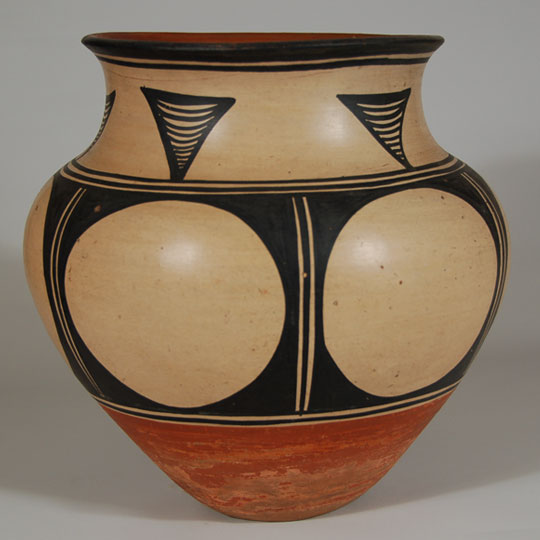 The Aguilar sisters were very adept at designing their jars. They were master potters and painters long before collectors were ready for something as creative and out of the norm as their works. They departed from traditional Santo Domingo designs and created designs of their own. Tourists, because of its departure from tradition, did not immediately accept their work. The casual tourist was familiar with the cheap curios and was happy to go home with some knickknack as a souvenir and proudly display it as a "genuine Indian" article.
The Aguilar sisters were very adept at designing their jars. They were master potters and painters long before collectors were ready for something as creative and out of the norm as their works. They departed from traditional Santo Domingo designs and created designs of their own. Tourists, because of its departure from tradition, did not immediately accept their work. The casual tourist was familiar with the cheap curios and was happy to go home with some knickknack as a souvenir and proudly display it as a "genuine Indian" article.
Miniature Papago Basket of Grass and Devil’s Claw Fibers - C3353.01
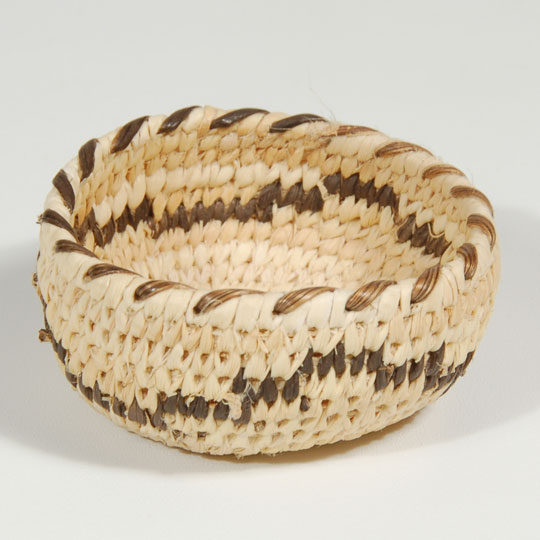 The Tohono O'odham are indigenous Native Americans who reside primarily in the Sonoran Desert of southern Arizona and northwestern Mexico. Tohono O'odham means "Desert People." The federally recognized tribe is known as the Tohono O'odham Nation.
The Tohono O'odham are indigenous Native Americans who reside primarily in the Sonoran Desert of southern Arizona and northwestern Mexico. Tohono O'odham means "Desert People." The federally recognized tribe is known as the Tohono O'odham Nation.
The Tohono O'odham have rejected the former name Papago, used by Europeans after being adopted by Spanish from hearing other Piman bands call them this. The Pima were competitors and referred to the people as Ba:bawĭkoʼa, meaning "eating tepary beans." That word was understood as papago by the Spanish and adopted by later English speakers.
Original Oil Painting entitled “Rabbit Hunt—Taos” by Helen Blumenschein - 25777
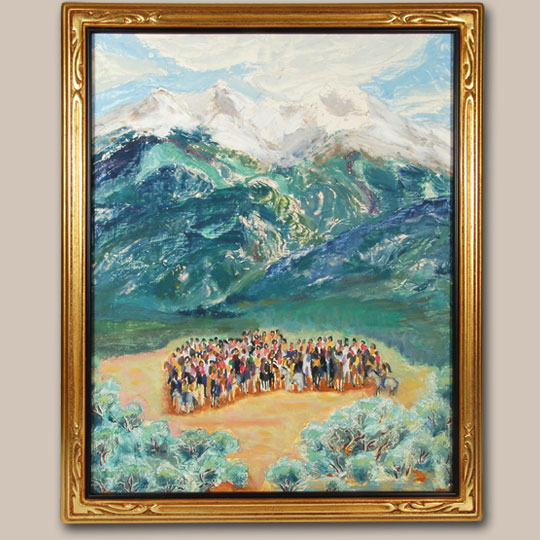 The Native American attitude toward killing animals unnecessarily is well established and historically recorded. They kill animals when needed for food or other necessities, but not for sport.
The Native American attitude toward killing animals unnecessarily is well established and historically recorded. They kill animals when needed for food or other necessities, but not for sport.
There was a time when American bison roamed in limited numbers in the area north and east of Taos Pueblo and the Taos men would organize buffalo hunts on an annual basis. As the bison population dwindled with trappers killing them for their hides for trade, the bison hunts slowed and came to an end. The last recorded bison hunt by men of Taos Pueblo was in 1884 in the Texas Panhandle. Grant 1925
Gigantic Cochiti Male Storyteller with 11 kids by Buffy Cordero Suina - C3688.07
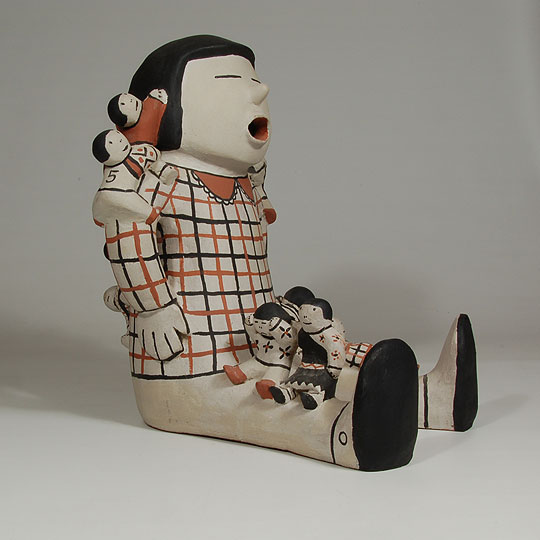 Buffy Cordero Suina (1969- ) was a granddaughter of Fred and Helen Cordero. Her mom and dad were George and Kathy Cordero. She credits her interest in pottery to her dad and her grandmother. It is most likely that Helen had more influence on Buffy as it appears that she quit potting following the death of Helen. Buffy started making storyteller figurines around 1985 while still a teenager.
Buffy Cordero Suina (1969- ) was a granddaughter of Fred and Helen Cordero. Her mom and dad were George and Kathy Cordero. She credits her interest in pottery to her dad and her grandmother. It is most likely that Helen had more influence on Buffy as it appears that she quit potting following the death of Helen. Buffy started making storyteller figurines around 1985 while still a teenager.
Beautiful Sikyatki Revival Vessel Shape Hopi-Tewa Jar by Nampeyo of Hano - C3823
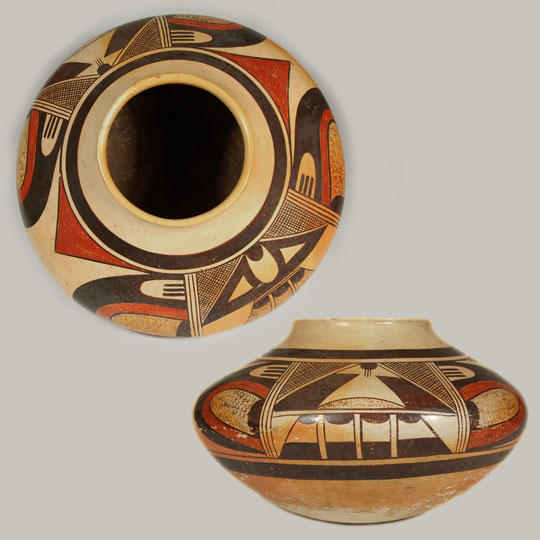 We are often drilled by clients to explain the meaning of designs on pottery. Some designs are relatively easy to interpret but others may or may not be identifiable and related to something with which we are familiar. We have a good escape route in Nampeyo of Hano pottery because we remind clients that designs used by Nampeyo were based on potsherds being excavated at a prehistoric site that existed a thousand years ago. Even if we think we can interpret a design, it may not be what the potter had in mind a thousand years ago. Also, Nampeyo used the potsherds for inspiration, not for copying.
We are often drilled by clients to explain the meaning of designs on pottery. Some designs are relatively easy to interpret but others may or may not be identifiable and related to something with which we are familiar. We have a good escape route in Nampeyo of Hano pottery because we remind clients that designs used by Nampeyo were based on potsherds being excavated at a prehistoric site that existed a thousand years ago. Even if we think we can interpret a design, it may not be what the potter had in mind a thousand years ago. Also, Nampeyo used the potsherds for inspiration, not for copying.


